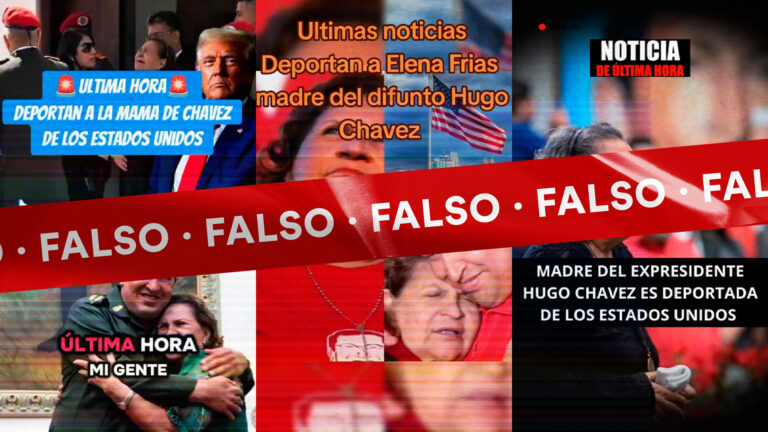A network of anonymous news outlets on Instagram targeting opposition readers has been a recurrent source of disinformation since 2019. It remains active in 2023.
- The network of accounts often spreads content that reinforces the narratives of Nicolás Maduro’s government, highlighting its supposed achievements, attempting to discourage migration, delegitimizing critical actors, and deepening existing rifts and divisions among different Venezuelan opposition groups.
- Some of their content has gone viral and has been featured on Venezuelan public television.
- There is evidence of coordination between the group of fake news assets on Instagram and other disinformation networks active on Twitter and YouTube.
By Adrián González for Cazadores de Fake News and C-Informa. Original article in spanish.

Disinformation is polluting social networks, hindering the fragile ability of civil society to discern the boundaries between truth and falsehood.
It’s highly likely that thousands of Venezuelan Instagram users have been systematically and continuously exposed to socio-political disinformation due to the actions of a network of anonymous accounts disseminating news content. Collectively, these accounts amass over 1.25 million followers and have been active since at least 2019.
This specific network of anonymous news outlets on Instagram was dubbed «The Disinformation Factory» by Cazadores de Fake News following an article the organization published in August 2020. Since then, it have identified it as the source of dozens of socio-political hoaxes in the Venezuelan context. For several years, it has polluted a social network through which many Venezuelan internet users get their information, many of whom oppose Nicolás Maduro’s regime and usually try to avoid exposure to propagandistic and misleading content broadcast on traditional and digital media controlled by the government that —in the prevailing communication hegemony— easily reaches every corner of Venezuela.
From immigration hoaxes and propaganda about improvements in the national economy to defamatory content against Venezuelan journalists and decontextualized videos aimed at deepening the already existing rifts among the multiple leaders of the Venezuelan opposition and fanning their internal divisions, «The Factory» accounts are a recurrent source of hoaxes, disinformation, and propaganda. Occasionally, this content permeates other social networks and goes viral.
The Information Coalition «C-Informa» was able to identify 306 posts shared by at least one of the six Instagram accounts that make up the anonymous news outlets group. They analyzed the type of content disseminated by the disinformation network and signs of synchronization between the content published on Instagram and disinformation campaigns on other social networks. Their analysis revealed what seems to be an ongoing influence operation, meaning a campaign that uses coordinated, malicious, or manipulative information and narratives to promote its objectives and gain competitive advantages over adversaries.
The aim of this investigation is to alert the Venezuelan population to the existence of networks of accounts that appear to be informative and target the opposition audience, but prove to be disinformation hubs. The goal is to enhance the resilience of Venezuelan civil society regarding the digital information contamination issue affecting them.
The False Rumor of COVID-19’s Arrival in Venezuela
Around noon on February 29, 2020, attendees at a gathering in Barquisimeto, a major city in the central-western part of the country, in support of Juan Guaidó — recognized as the Interim President of Venezuela until January 2023 — were attacked by armed groups. Unknown assailants used firearms, stones, and explosives against the attendees, injuring at least five people and shattering the windows of a vehicle used by his entourage.
That same evening, Guaidó reiterated the call for an opposition march set for March 10 in Caracas, with the endpoint being the Federal Legislative Palace, the home of Venezuela’s National Assembly.
By the end of February, the arrival of COVID-19 in Venezuela had not yet been officially announced. The disease had been named only about two weeks prior — most Venezuelans still referred to it as the «Coronavirus» — and the outbreak hadn’t even been declared a «pandemic» by the World Health Organization, which would happen on March 11.
Nevertheless, rumors about the supposed arrival of the virus in the country began circulating earlier in the year, like a false case allegedly detected at the Chilemex Clinic in Puerto Ordaz, Bolívar state (in the south), which was debunked in the last week of January.
However, on the night of the attack in Barquisimeto, the rumor resurfaced. At 8:00 p.m. on February 29, the hashtag #CoronavirusEnVzla began to trend suddenly on Twitter, driven by a coordinated group of accounts that, posting a large volume of spam tweets and without presenting any evidence about the virus’s arrival in the country, positioned it as the top trending topic in Venezuela.
The next day, on March 1, at around 3:44 p.m., five anonymous Instagram accounts posing as news sources began sharing a photo of two elderly individuals on stretchers, claiming they were «alleged Coronavirus cases in Puerto Ordaz» being treated at the Caroní Clinics Hospital. Within hours, journalists and media outlets verified the information and debunked it as a hoax. The photos were unrelated to Venezuela; they had been published by a Dominican website on September 15, 2019, long before the virus’s existence was known globally.
Despite this, the rumor continued trending on Twitter on March 2. That day, the same organized team of Twitter users who boosted #CoronavirusEnVzla also pushed another hashtag, #CoronavirusEnPzo (Coronavirus in Puerto Ordaz), to the number 6 trending spot in Venezuela. The campaign aimed to popularize the rumor on Twitter about the two alleged Coronavirus cases in Puerto Ordaz, sharing the same photo of the Dominican elderly that had earlier been presented as real news on the anonymous Instagram news network.
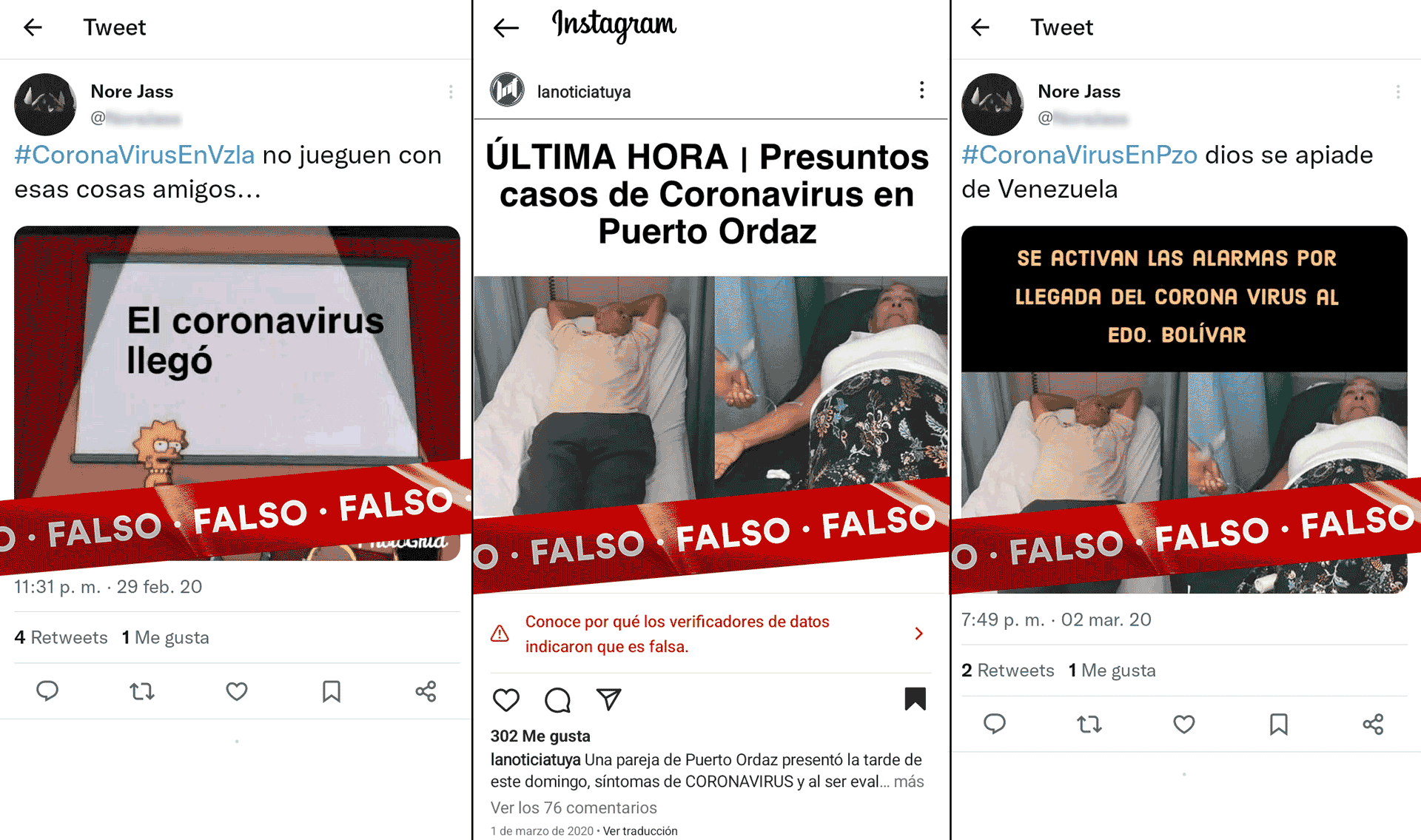
The campaign persisted for several days on both social networks. On Instagram, posts were shared on March 3, 7, 9, and 10 that aimed to keep the rumor alive. On Twitter, on March 3, 4, and 5, the trends #WaidoConCoronavirus, #GuaidonaVirus, and #GuaidoInfected were promoted.
Digital forensic evidence proves that the rumor about the false arrival of COVID-19 did not emerge spontaneously on social networks. It was undoubtedly a multi-platform influence operation, published on various social networks in a coordinated manner, attempting to amplify the rumor both to distract from the February 29 attack in Barquisimeto and to incite fear in civil society and impact the call for the march scheduled for March 10.
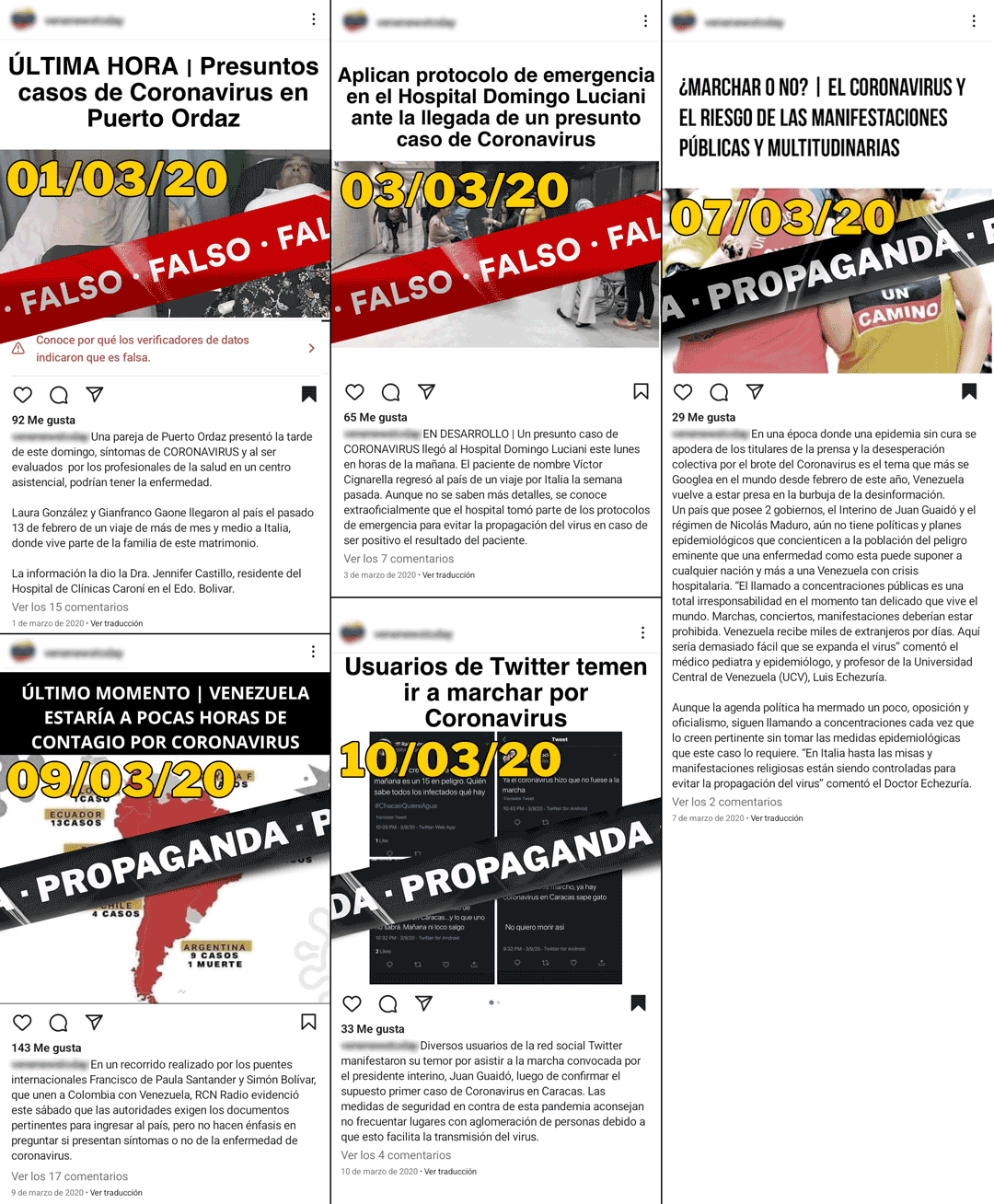
Shortly after the march, on March 12, Nicolás Maduro announced in a press conference the suspension and prohibition of large public gatherings and events. The following day, Delcy Rodríguez confirmed the first two COVID-19 cases in the country: two patients reported in Miranda state (north), over 450 km northeast of Puerto Ordaz.
Web of Lies Connecting Social Networks

When disinformation is systematically designed and amplified, it often leaves patterns, traces, or evidence that proves its intent
The rumor about the false arrival of COVID-19 to Venezuela in early March 2020 is far from the only case of disinformation whose inception and amplification is linked to the same disinforming actors identified on Instagram and Twitter.
According to data recorded by the Probox observatory and the Fake News Hunters organization, on at least 30 occasions between 2019 and 2022, coordinated campaigns were activated on both social networks to popularize hoaxes, hashtags, narratives, or propagandistic multimedia content. Precisely, the same anonymous news accounts on Instagram that form «The Disinformation Factory», as well as the same team of accounts that drove coordinated Twitter trends, participated.
One of these campaigns was pushed on Twitter on December 25, 2019, with the hashtag #WaidoEnLosRoques, a rumor about supposed holidays that Juan Guaidó and his family would have enjoyed during Christmas. This was covered the next day by five of the anonymous news outlets of «The Factory».
Another case emerged on February 3, 2020, when the same people responsible for popularizing Twitter hashtags #CoronavirusEnVzla and #WaidoEnLosRoques pushed #GuaidoYSuPrima, trying to highlight a new rumor about a fake relationship between Guaidó and Windy Guaidó, an urban music singer whose career would have been financed – according to the hoax – by the then-interim president. That same day, the rumor was featured on Instagram by «The Factory» accounts, and the next day, it was amplified internationally in the Spanish version of Mundo Sputnik, a propagandistic medium affiliated with the Russian government, which also appears in a study by Efecto Cocuyo for the C-Informa alliance on portals in Latin America that spread Russian, Cuban, and Venezuelan political disinformation.
According to what was confirmed to Fake News Hunters by spokespersons from Juan Guaidó’s communications team, Windy Guaidó was not part of the interim government he led and is not even known in the opposition leader’s family circle.
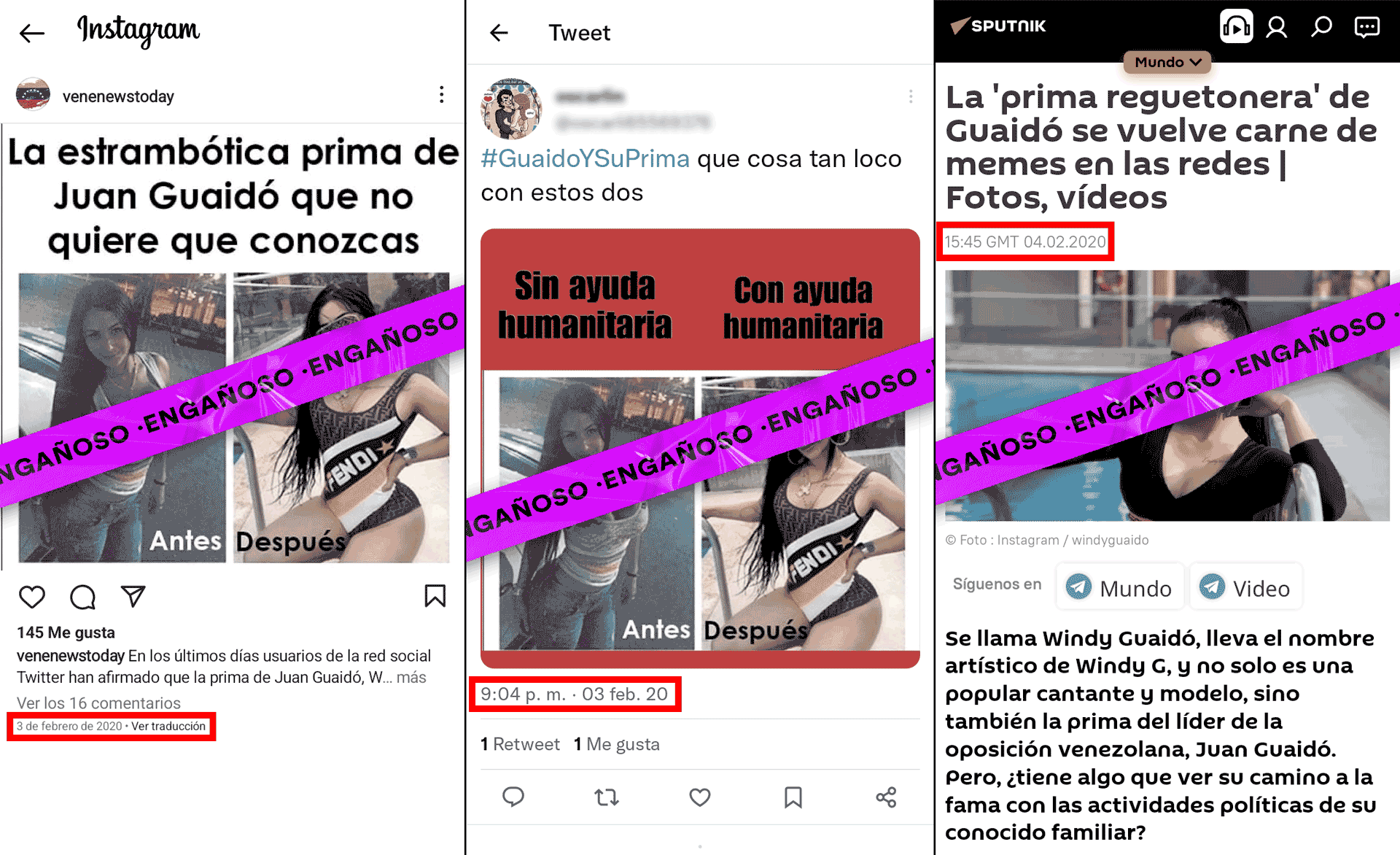
Several tweeters and researchers have been denouncing for years the techniques used by the same team of tweeters to manipulate Twitter’s algorithm and position hashtags at the top of the trending list for Venezuela, violating the social network’s policies against spam and platform manipulation.
It wasn’t until 2021 that Twitter permanently suspended the account leading the group of tweeters, belonging to a Venezuelan influencer nicknamed @NiTanTukky, after receiving information about a set of tweets from 2019 and 2020 forgotten in his timeline in which he explicitly offered payments between USD 100 and 150 to promote the misleading hashtags.
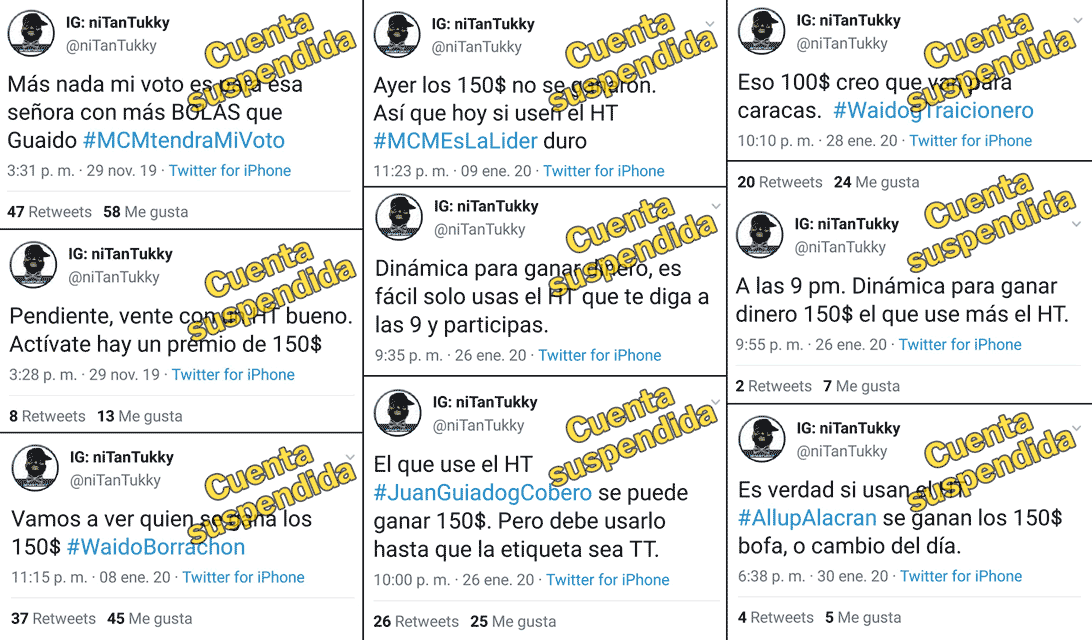
The group of Twitter accounts led by @NiTanTukky, pseudonym of the Venezuelan influencer Keisbel Giménez, is what in the study of disinformation is known as an astroturfing team – flesh and blood operators who try to position topics on the public agenda, pretending to spontaneously talk about them, but hiding their true intent. In 2023, this astroturfing team has occasionally pushed coordinated trends, but not with the same regularity or impact as in previous years.
While there are clear coincidences between the operation on Instagram and Twitter in terms of content type, objectives, and release date, so far it has not been possible to prove whether both networks are being operated by the same group of people.
However, in a study published in August 2022, it was evidenced that the misleading content disseminated on Instagram by «The Factory» and with the use of coordinated hashtags on Twitter also had connections with a network of six propaganda channels on YouTube whose administrators paid for advertising to promote some of their videos. The group of channels – which included House of News, a fake newscast narrated in English with presenters generated using Artificial Intelligence software – ceased operations in March 2023, being completely suspended by YouTube.
Despite the loss of influence of the team pushing coordinated trends on Twitter and the closure of the network of channels on YouTube, the network of anonymous news outlets on Instagram, «The Disinformation Factory», has continued to publish misleading content to date.
Is «The Factory» part of an organized disinformation strategy?

Since 2017, there had been warnings that the Bolivarian government intended to manipulate online content to defend itself from what it considers the «media war», simultaneously using tactics, techniques, and disinformation procedures, recruiting influencers, and even creating fake news outlets on social media.
In June of that year, the Press and Society Institute (IPYS) Venezuela chapter, published a presentation leaked online with the logo of the Ministry of People’s Power for Interior Relations, Justice, and Peace titled «Project for training the troll army of the Bolivarian revolution». In the document, whose implementation was never verified, the use of «press squads» was recommended. They would be responsible for creating news content, press releases, articles, and publications. According to the strategy, there would be several types of squads, including those of «fake news» or initiators of false positives. It was also suggested to purchase accounts «with more than 100,000 followers» on Instagram and Twitter with the goal of «covering news from different fields, some with a pro-government political line and others in opposition, to reach that audience«.
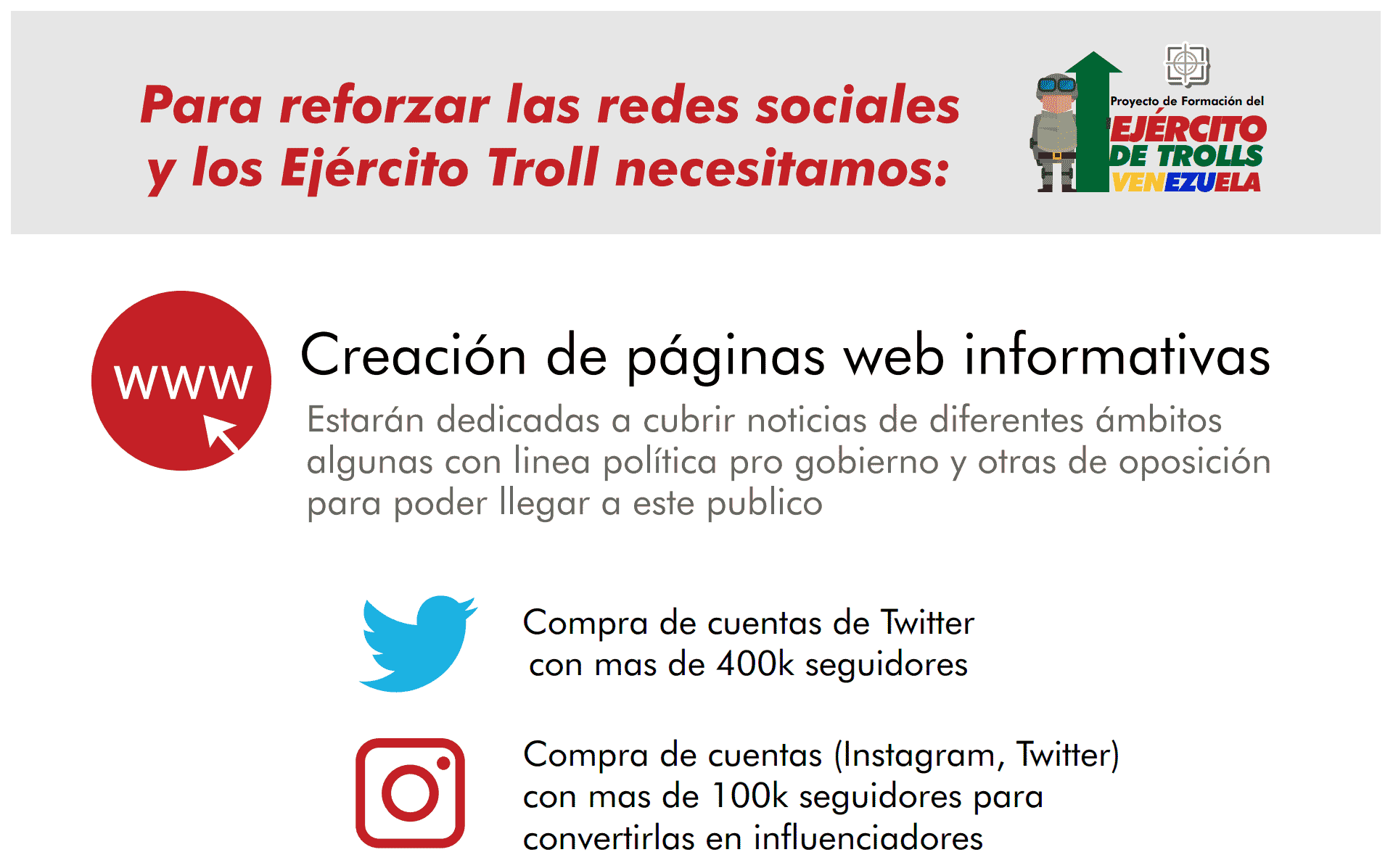
Given a precedent of intentionality, can it be verified if the guidelines outlined in the training project of the «troll army of the Bolivarian revolution» are related to the activity of anonymous or undercover news outlets on social media, as is the case with the accounts of «The Factory»?
Had the project been implemented, the anonymous news network on Instagram would be one of the main disinformation focal points on social media that would raise more suspicions of being related to what was suggested in the document.
In the research on «The Factory» published in August 2020, it had been confirmed, using the CrowdTangle tool from Meta and analyzing the publication dates and times, that the anonymous news network was the source of dozens of hoaxes, rumors, manipulated information, and toxic Venezuelan propaganda that in hours or days would be reproduced – unintentionally, in most cases – by other Instagram, Twitter, Facebook accounts, and occasionally on national public television. Since then, Fake News Hunters identified 18 additional cases that went viral on at least two social networks and originated from «The Factory». Similarly, they ruled out dozens of other publications from the anonymous news network that never went viral, even though they clearly identified them as disinformation.
In August 2020, the network consisted of 6 accounts, two of which are currently suspended (@VenezuelaGrita and @CiudadanoVenezolano).
By March 2023, the network comprises six linked accounts:
- @VeneNewsToday (ID: 1355770473): with 27 previous usernames, including @58Turismo and @LaNoticiaDeVzla. It has more than 58,000 followers.
- @LaNoticiaTuya (ID: 5646951525): with 10 previous usernames like @VzlaInformacion and @LaLupaVe. Over 64,000 followers.
- @ElObservadorVe (ID: 3118816757): with 7 previous names, not identified. Over 373,000 followers.
- @VivoPorVenezuela (ID: 10446015054): with 7 previous names, not identified. Over 128,000 followers.
- @AraguaLucha (ID: 5413330422), over 211,000 followers.
- @TodosContigoVenezuela (ID: 15479999557), over 423,000 followers.
In the particular case of «The Factory», usernames should only be considered as reference information since several network accounts regularly change their usernames, especially after a debunking of the hoaxes they started or participated in is published. This camouflage technique is also used by the Twitter team accounts linked with @NiTanTukky, according to observations by Cazadores de Fake News.
Deconstructing a «Disinformation Lab»
What other rumors, hoaxes, and manipulations were posted on Instagram by the anonymous news outlets of «The Factory» during the time they have been active? At what time have they generated the most disinformation and on which topics?
Using CrowdTangle and the date and time data of hundreds of tweets posted by the accounts, a database was assembled with a sample of 306 pieces of disinformation or propagandistic content shared by at least one of the network’s accounts between March 2019 and January 2023.
The database of publications was organized according to the narrative driven, the target actor of the content, and the disinformation technique used. The results are displayed in the following tree diagram.
The content posted by anonymous news outlets is not entirely disinformation or propaganda, nor is it identical. Several of the channels publish content heterogeneously, interspersing real news, typically sourced from Venezuelan digital media such as La Patilla, AlbertoNews, or DolarToday, with advertising, memes, and occasionally the original disinformative and propagandistic content identified in the database. The same content was published almost simultaneously by at least two accounts from «The Factory» in 134 of the indexed cases, which can give potential followers the impression that it’s important or «breaking news» when seeing it suddenly appear on multiple Instagram accounts.
This is one of the main reasons why the anonymous news outlets are considered a network. Two of the accounts (@VeneNewsToday and @LaNoticiaTuya) tend to be the first to publish disinformative content and, in 12 of the indexed cases, published the same content within a 60-second interval, suggesting they are operated by the same person. The same goes for the remaining four accounts (@ElObservadorVe, @VivoPorVenezuela, @TodosContigoVenezuela, and @AraguaLucha), which also exhibit coincidences in publishing the same type of content almost simultaneously, with differences of minutes or seconds.
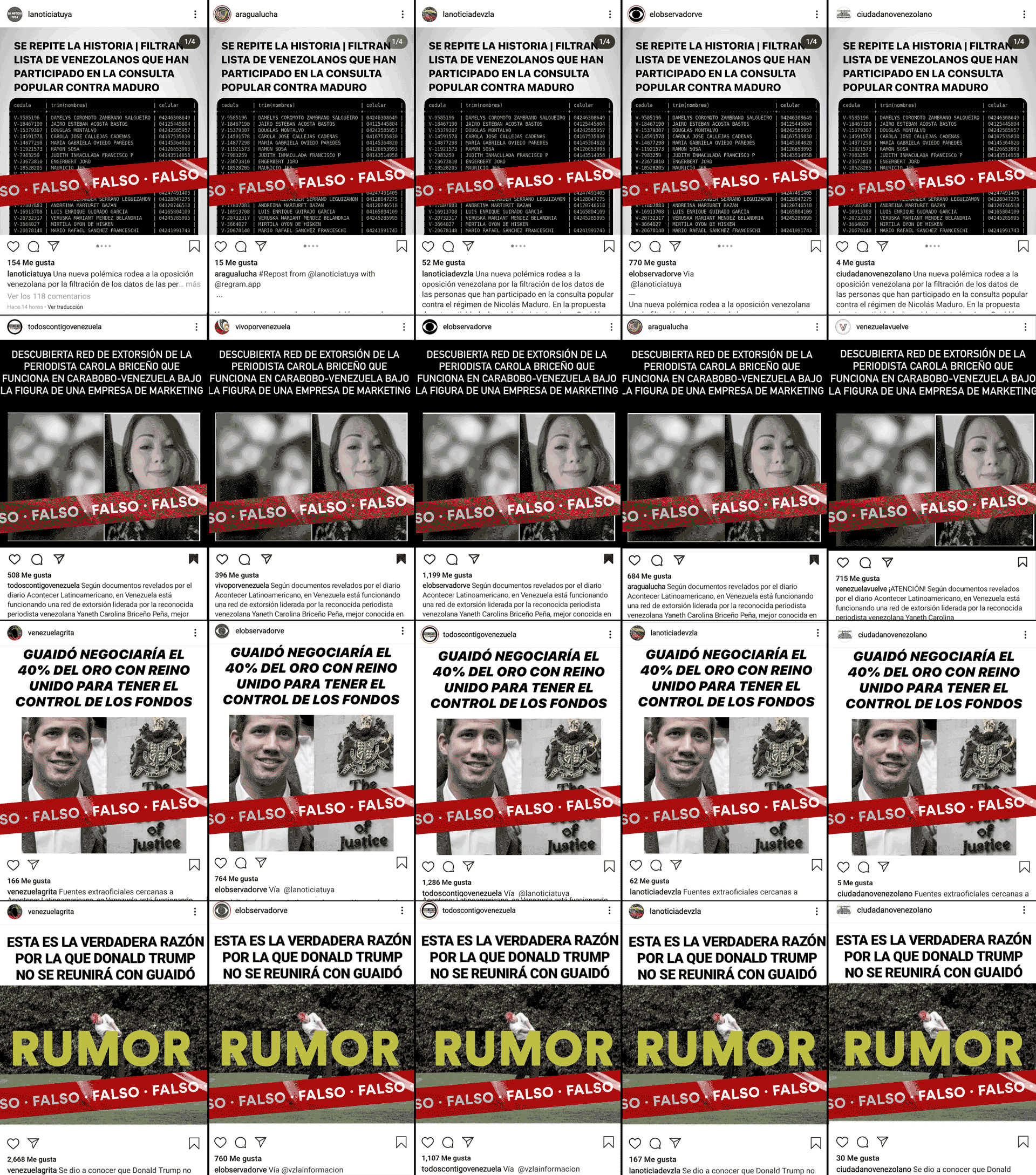
During the studied period, the anonymous news network posted the most content during three specific months:
- May 2020: 24 distinct posts, following the events of the so-called Operation Gideon (img. 01).
- December 2020: 23 distinct posts, in the weeks leading up to the Popular Consultation promoted by the Venezuelan opposition (img. 02).
- October 2021: 20 distinct posts, in the context of the negotiation and dialogue process between the government and the Venezuelan opposition and weeks before the legislative election campaign on November 21 (img. 03).

The main actors mentioned in the posts indexed in the database are Juan Guaidó (89 posts, 29% of the total), Leopoldo López (55 posts, 17.97% of the total), the interim government (24 posts, 7.84% of the total), and elections in Venezuela (11 posts, 3.59% of the total).
The disinformative content that begins to spread on “The Factory” accounts employs a wide range of disinformative techniques, including 14 cases of content forgeries:
- Forged Documents: fake leaked databases, supposedly coming from democratic initiatives of the Venezuelan opposition such as the 2020 Popular Consultation (img. 04), the “Health Heroes” program driven by the interim government (img. 05), or forged documents like a fake investigation from the Colombian prosecutor’s office against the interim government (img. 06).
- False opinions or comments from reliable sources: fabricated statements from the director of the District Capital College of Psychologists (img. 07), a journalist from the Spanish newspaper El País (img. 08), or a journalist from the Argentine newspaper La Nación (img. 09). In this last case, the hoax was removed by the anonymous news outlet that published it after the journalist herself debunked it in the same post.
- False social media posts from influential actors: videos never published by well known media outlets, polls never posted on Twitter by influential journalists (img. 10), tweets never posted by influential actors (img. 11), and poll results never released by Venezuelan polling firms (img. 12).
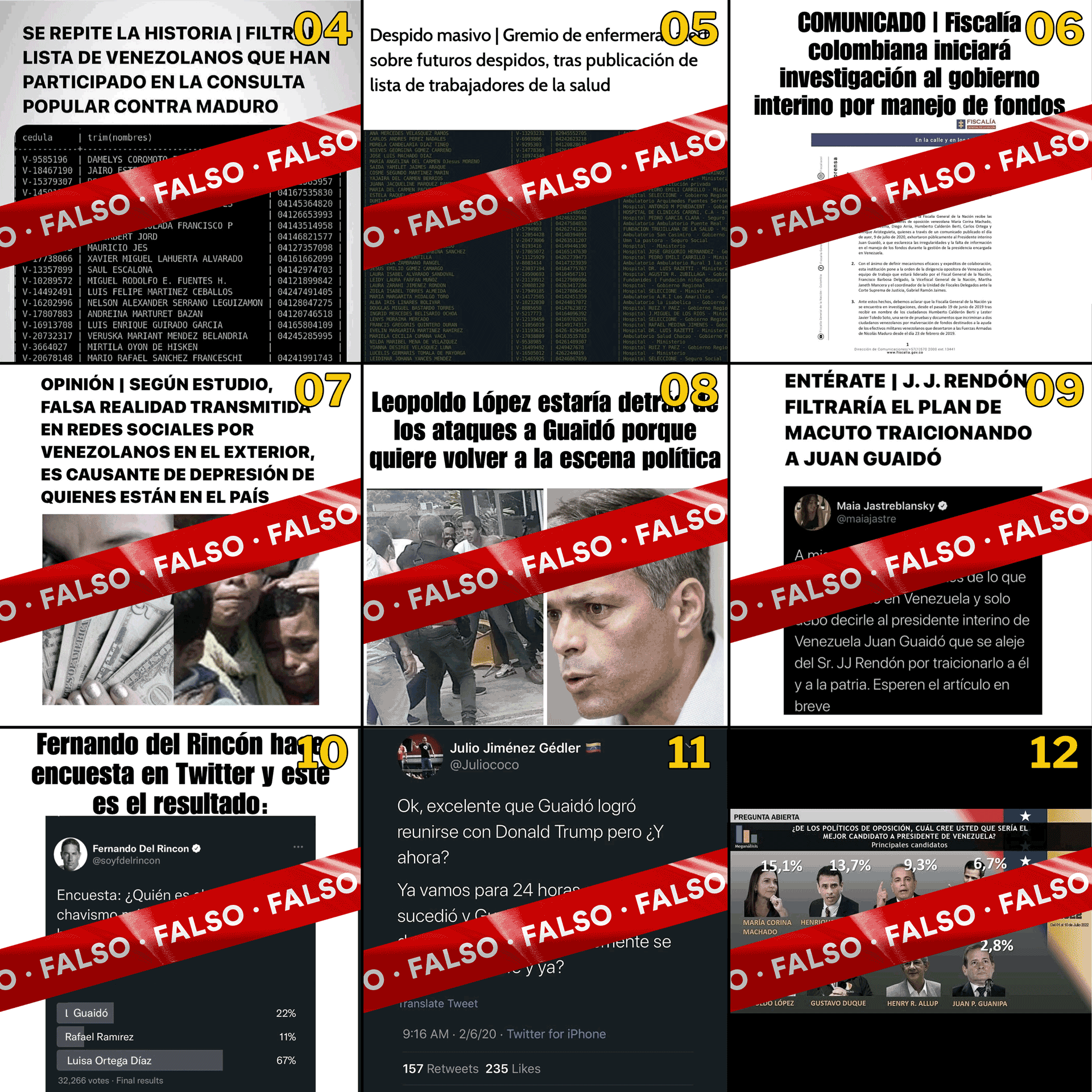
However, not all disinformative content is based on forgeries. There is a pattern present in dozens of the indexed cases: the use of misleading information, based on real events or content that was deliberately distorted to harm their targets.
Some of the disseminated content includes personal documents spread with deceptive narratives (img. 13), out-of-context private images and videos (img. 14, 15, and 16), misleading information about humanitarian aid (img. 17), hoaxes with completely fabricated information with the deliberate intent to harm (img. 18, 19, 20), and memes that amplify existing propagandistic narratives.
Not all cases, however, appeared on social networks through “The Factory.” Some were first involved with the trend manipulation network on Twitter (img. 10, 13, 21), troll accounts or communicators of Chavismo on Twitter (img. 12), or were even first presented by representatives of Nicolás Maduro’s government and then circulated on social networks (img. 14).
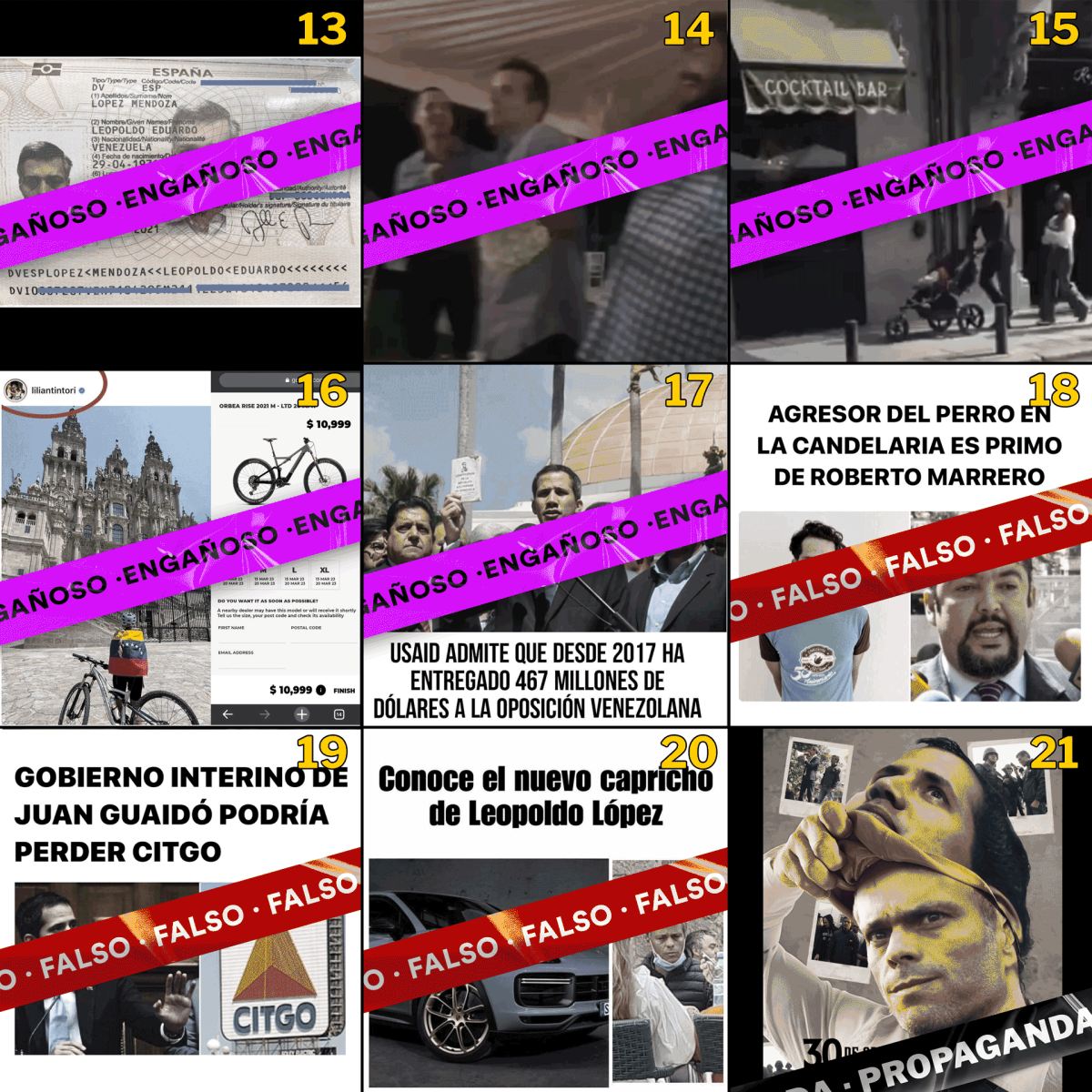
On at least six occasions, content spread by “The Factory” was featured on the state channel Venezolana de Televisión through the program «Con El Mazo Dando,» hosted by Diosdado Cabello.
Three of the posts were directly mentioned by Cabello (img. 13, 14, 20) while the rest appeared as part of thematic segments against opposition figures broadcasted at the end of the show (img. 16, 21, 23). The program is a regular source of disinformation and toxic propaganda against politicians and parties, journalists, and independent Venezuelan media.
Juan Guaidó, Leopoldo López, and the interim government were not the only figures from the Venezuelan opposition targeted by content from «The Factory» on Instagram, which was later amplified on other social networks.
The database also includes content targeting leaders of the Venezuelan political opposition – such as María Corina Machado, Henrique Capriles Radonsky, Henry Ramos Allup, and Delsa Solórzano – as well as figures from the regime who have recently confronted the Bolivarian government, like former Attorney General Luisa Ortega Díaz or former Minister Rafael Ramírez.
In all instances, the publications seem to aim at deepening already existing rifts and fueling polarization among the various adversaries of the Venezuelan regime, a disinformation strategy identified by Cazadores de Fake News in programs aired on public television, like the aforementioned «Con El Mazo Dando» or «La Hojilla», hosted by Mario Silva.
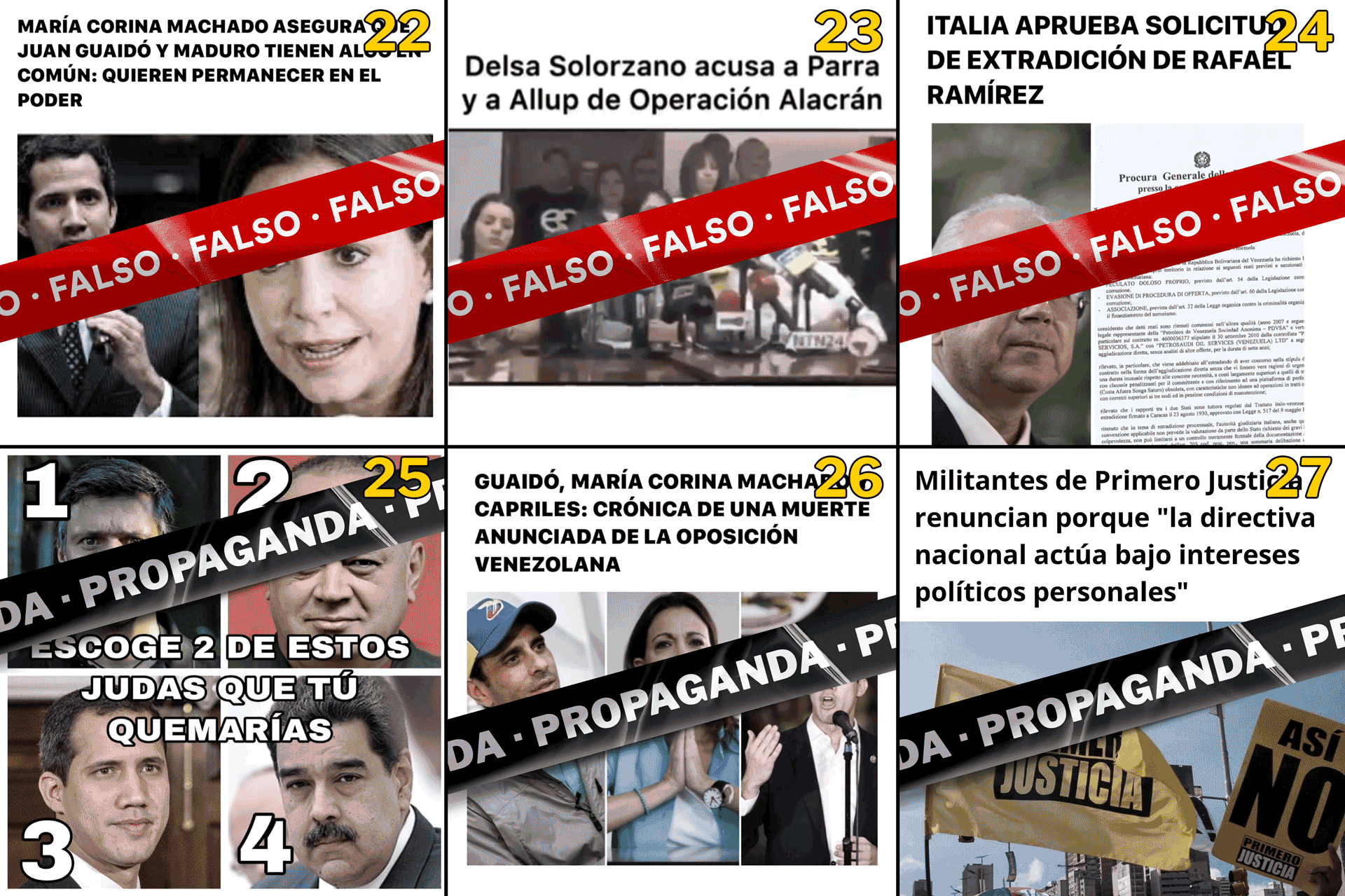
But there is also disinformation content published by “The Factory” related to democratic or citizen participation processes, which can provide clues about the kind of information manipulation that might be expected in Venezuela in similar future processes.
As explained earlier, in early 2020 the network of anonymous news outlets shared a series of six distinct posts about the false arrival of COVID-19 in Venezuela, presumably attempting to weaken participation in the March 10th march of that year. In the case of the Popular Consultation, the disseminated content also sought to undermine opposition participation in the initiative, which could promote uncertainty in the process and stoke fears of potential political retaliation, as three of the publications in the database referred to the false sale of the Popular Consultation’s database by its very organizers.
Among the selected publications, intentions to influence readers on topics such as the regional elections of November 21, 2021 (img. 28 to 30) and the negotiation process between the opposition and the regime (img. 31 to 33) can also be identified.
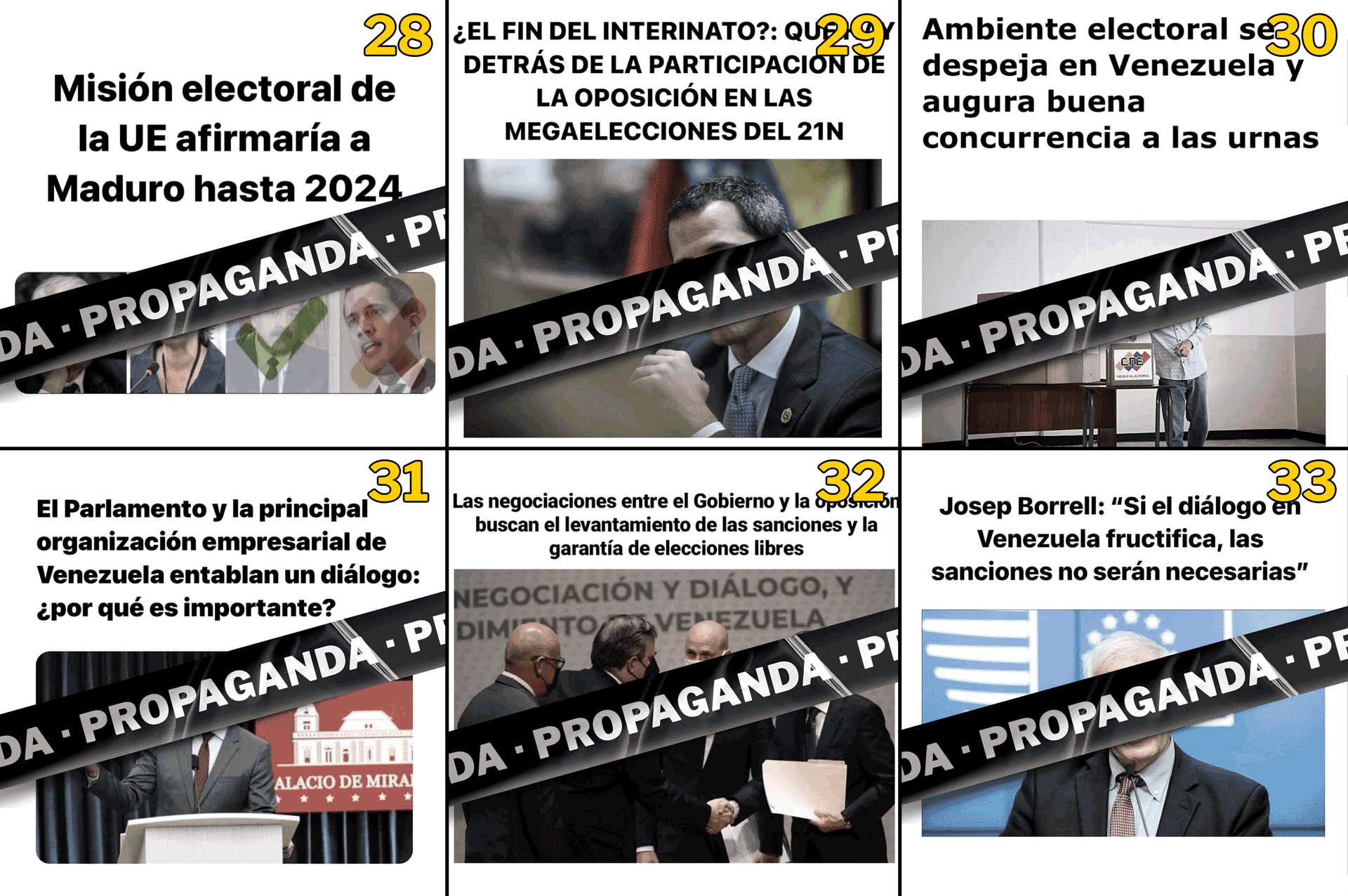
Many other identified publications lie on the boundary between disinformation and propaganda, feeding narratives about improvement or prevailing normality in Venezuela (in 16 cases) or about the supposed reliability of electoral processes in the country (in 13 cases).
There’s a set, however, composed directly of informative or propagandistic content related to Nicolás Maduro (img. 34 and 35) or directors of Venezuelan police or intelligence agencies like Douglas Rico, Director of the Scientific, Penal and Criminal Investigation Corps, CICPC (img. 36); Alexander Granko Arteaga, Head of the Special Affairs Unit (DAE) of the Directorate General of Military Counterintelligence, DGCIM (img. 37 to 39); and Rafael Bastardo, former operations chief of the Special Actions Force (FAES) of the National Bolivarian Police, PNB (img. 40 to 42).
While the appearance of this type of content in the database is minimal compared to topics in other cases, it’s noteworthy that all publications about Granko Arteaga, posted on some of «The Factory» accounts between February 9 and 11, 2022, were deleted from anonymous news outlets on Instagram days later.
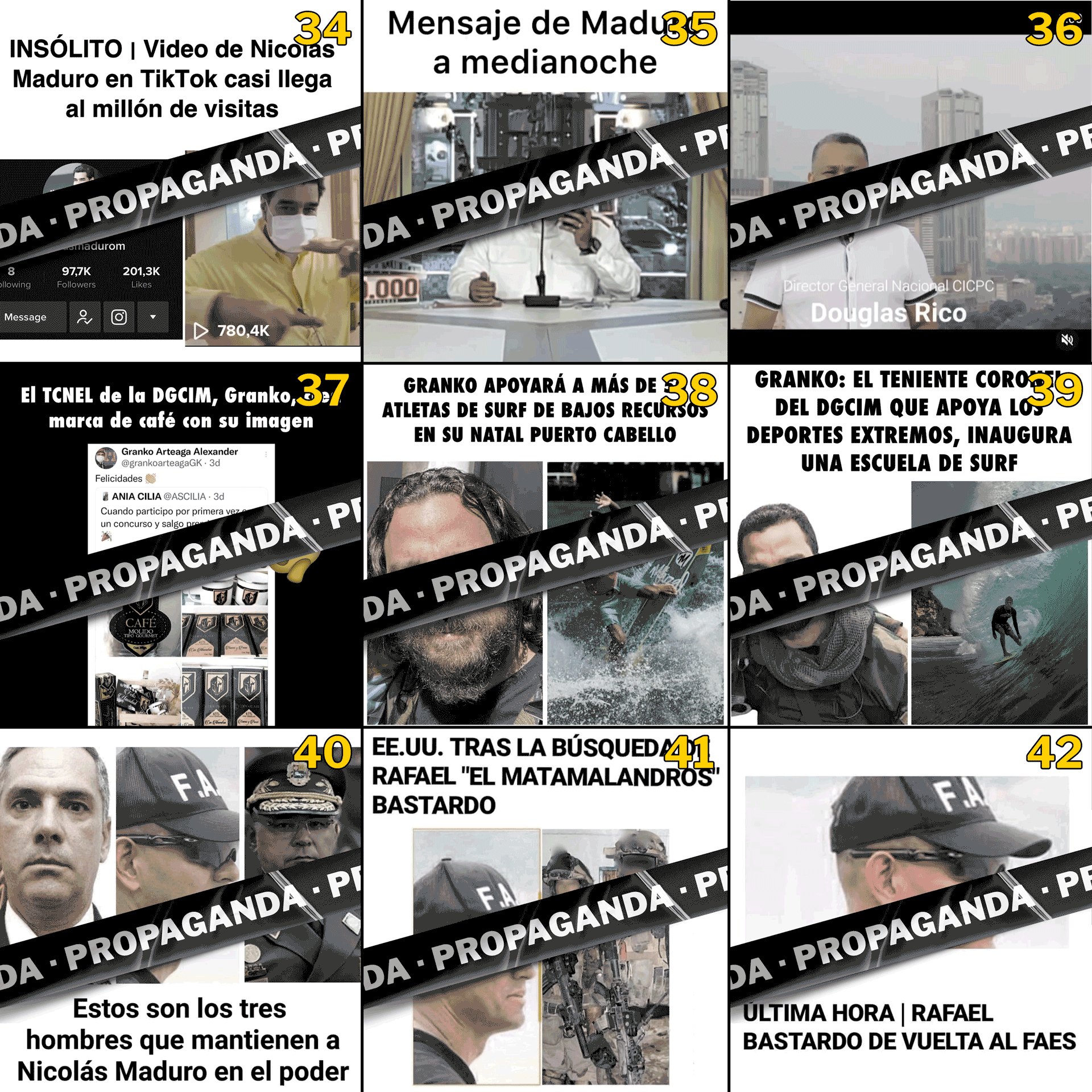
Though the presence of this content in the database is small compared to other topics, it stands out that all publications about Granko Arteaga, posted on some of «The Factory» accounts from February 9 to 11, 2022, were deleted from anonymous news outlets on Instagram just days later.
What can civil society learn from «The Factory»?

Are the anonymous news outlets that make up «The Disinformation Factory» on Instagram digital assets being used in an influence operation linked to Nicolás Maduro’s government, are they managed by spontaneous sympathizers of the regime, or simply commercial accounts offering content publishing services, even if it’s disinformation, to whoever can pay for it?.
As has been documented in countries like Russia, the covert promotion of disinformation on social networks is an information warfare strategy designed to deny attributions and connections with its beneficiaries. And while in the case of «The Factory» its operation cannot be attributed to any specific actor, the narratives it has promoted clearly indicate that it’s an asset frequently used in the context of information warfare in Venezuela.
Even though the content posted by «The Factory» since 2019 has mainly targeted opposition politicians like Juan Guaidó and Leopoldo López, it’s crucial to understand that the positions they held as targets of the disinformation generated by the network could be replaced by other political actors who pose a threat to the Venezuelan regime. It’s expected that these disinformation tactics will intensify during significant electoral processes, like the opposition primaries and the 2024 presidential elections.
It’s not enough for civil society to vehemently reject the political use of disinformation or passively access debunkings, clarifications, and reports from media outlets and Venezuelan verification initiatives. To combat this problem, it must be prepared for the deployment of similar influence operations in the digital arena, and the first step is to understand that this type of content does not appear spontaneously on social networks.
Promoting media and information literacy among Venezuelan readers is vital, with the ultimate goal that they can discern between reliable sources and disinforming actors, like the anonymous news outlets of «The Factory» or the network that drives coordinated trends on Twitter. Venezuelan media, organizations, and institutions have started training programs for communicators and civil society leaders in recent years, but there’s still a long way to go.
Education is the most sustainable path to provide citizens with tools to shield themselves against the spread of disinformation and the deployment of influence operations, safeguarding their right to access accurate and timely information.
This work is part of the deliveries of the Information Coalition «C-Informa», a Venezuelan journalistic team aiming to counter disinformation and is made up of Medianálisis,Efecto Cocuyo,El Estímulo,Cazadores de Fake News yProbox with the support of Consorcio para Apoyar el Periodismo Independiente en la Región (CAPIR) and the advice from Chequeado from Argentina and DataCrítica from México.


